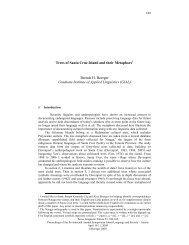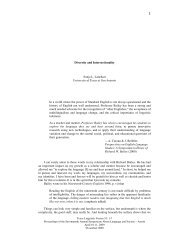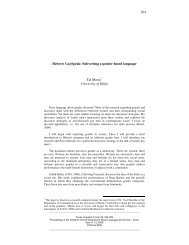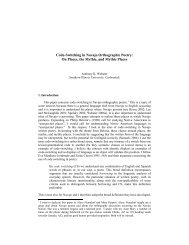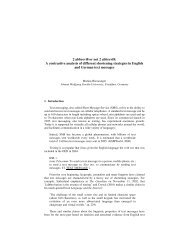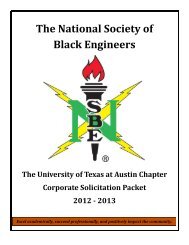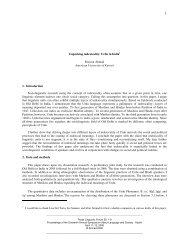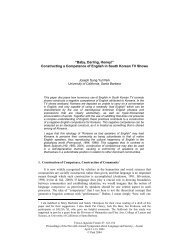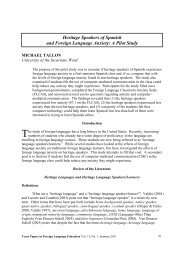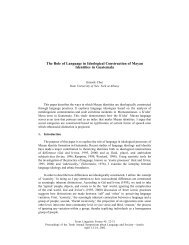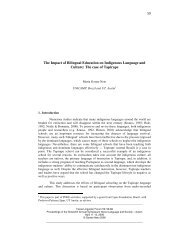The Effects of Computer-Mediated Communication on Foreign ...
The Effects of Computer-Mediated Communication on Foreign ...
The Effects of Computer-Mediated Communication on Foreign ...
You also want an ePaper? Increase the reach of your titles
YUMPU automatically turns print PDFs into web optimized ePapers that Google loves.
creating individual differences in language learning. Horwitz (2001) notes that several studies<br />
have found foreign language anxiety to be largely independent <str<strong>on</strong>g>of</str<strong>on</strong>g> other types <str<strong>on</strong>g>of</str<strong>on</strong>g> anxiety.<br />
Some researchers believe that CMC can create an envir<strong>on</strong>ment in which foreign language<br />
anxiety is reduced. Kro<strong>on</strong>enberg (1994/1995) states that “the most timid language students can<br />
come alive while creating meaningful communicati<strong>on</strong> via the keyboard and screen” (p. 24).<br />
Kern (1995) reported that most students enjoyed CMC, with some evidence <str<strong>on</strong>g>of</str<strong>on</strong>g> reduced anxiety.<br />
Warschauer (1996) states that students reported “that they did not feel stress during electr<strong>on</strong>ic<br />
discussi<strong>on</strong>” (p. 16). Sullivan & Pratt (1996) state: “Hypothetically, the networked classroom<br />
would <str<strong>on</strong>g>of</str<strong>on</strong>g>fer the less pr<str<strong>on</strong>g>of</str<strong>on</strong>g>icient speaker more time to think about what to „say,‟ thus reducing<br />
anxiety and the probability <str<strong>on</strong>g>of</str<strong>on</strong>g> error” (p. 492).<br />
In a descriptive study <strong>on</strong> students‟ attitudes and motivati<strong>on</strong> <strong>on</strong> E-talk, Beauvois (1995)<br />
reports that over 70% <str<strong>on</strong>g>of</str<strong>on</strong>g> the students felt that the computer lab was much less anxiety-provoking<br />
than the regular classroom and 73% indicated that they would like to spend more time working<br />
in the lab. Based <strong>on</strong> 76 student interviews from all levels <str<strong>on</strong>g>of</str<strong>on</strong>g> classes over a three-year period,<br />
Beauvois (1999) reports that student resp<strong>on</strong>ses to CMC were unanimously positive <strong>on</strong> the<br />
questi<strong>on</strong> <str<strong>on</strong>g>of</str<strong>on</strong>g> stress/anxiety; students also commented <strong>on</strong> the social aspects <str<strong>on</strong>g>of</str<strong>on</strong>g> CMC and how it<br />
creates a sense <str<strong>on</strong>g>of</str<strong>on</strong>g> community and a socially supported envir<strong>on</strong>ment. Beauvois c<strong>on</strong>cludes:<br />
“What we do know now is that…we can use networked computers in our classrooms without<br />
activating anxiety in our students and without inhibiting their participati<strong>on</strong>” (p. 162).<br />
G<strong>on</strong>zález-Bueno & Pérez (2001) explored the significance <str<strong>on</strong>g>of</str<strong>on</strong>g> the overall effect <str<strong>on</strong>g>of</str<strong>on</strong>g> using<br />
e-mail in the quantity and accuracy <str<strong>on</strong>g>of</str<strong>on</strong>g> Spanish written language generated by the electr<strong>on</strong>ic<br />
media through dialogue journals compared to the paper-and-pencil versi<strong>on</strong> <str<strong>on</strong>g>of</str<strong>on</strong>g> the technique.<br />
Qualitative analysis revealed that a majority (86%) <str<strong>on</strong>g>of</str<strong>on</strong>g> the experimental students believed the<br />
assignment had improved their attitude towards the language, and half <str<strong>on</strong>g>of</str<strong>on</strong>g> them felt that the email<br />
journal had some advantages over its paper-and-pencil counterpart (including learning to<br />
communicate, self-m<strong>on</strong>itoring, using technology appropriately, finding the assignment fun); <strong>on</strong><br />
the other hand, <strong>on</strong>ly <strong>on</strong>e third <str<strong>on</strong>g>of</str<strong>on</strong>g> the c<strong>on</strong>trol subjects claimed that this practice was<br />
communicative, creative, meaningful and <strong>on</strong>e that produced low anxiety.<br />
Arnold (2002) investigated the relati<strong>on</strong>ship between CMC and foreign language anxiety<br />
in five secti<strong>on</strong>s <str<strong>on</strong>g>of</str<strong>on</strong>g> third-semester German classes (N=56) with SCMC, ACMC, and a traditi<strong>on</strong>al<br />
face-to-face class. She found that students‟ self-ratings <str<strong>on</strong>g>of</str<strong>on</strong>g> their anxiety and self-c<strong>on</strong>fidence<br />
levels during each discussi<strong>on</strong> did not change significantly between the three treatment groups<br />
(although 29% <str<strong>on</strong>g>of</str<strong>on</strong>g> the students experienced moderate levels <str<strong>on</strong>g>of</str<strong>on</strong>g> anxiety and 19% experienced high<br />
levels <str<strong>on</strong>g>of</str<strong>on</strong>g> anxiety); all groups generally enjoyed the group discussi<strong>on</strong>s, although the e-mail group<br />
(ACMC) provided some negative feedback (due to the lag time); in all three treatment groups,<br />
students displayed significantly lower levels <str<strong>on</strong>g>of</str<strong>on</strong>g> anxiety after the study (although modality did not<br />
have any effect <strong>on</strong> these changes). Arnold suggests using e-mail exchanges for writing practice<br />
instead <str<strong>on</strong>g>of</str<strong>on</strong>g> electr<strong>on</strong>ic discussi<strong>on</strong>s.<br />
In a later study, Arnold (2007) investigated the relati<strong>on</strong>ship between CMC and<br />
communicati<strong>on</strong> apprehensi<strong>on</strong> (<strong>on</strong>e aspect <str<strong>on</strong>g>of</str<strong>on</strong>g> the foreign language anxiety c<strong>on</strong>struct proposed by<br />
Horwitz, Horwitz & Cope, 1986). Data from pretest and posttest questi<strong>on</strong>naires showed no<br />
significant differences in a reducti<strong>on</strong> <str<strong>on</strong>g>of</str<strong>on</strong>g> communicati<strong>on</strong> apprehensi<strong>on</strong> between the c<strong>on</strong>trol and<br />
experimental groups.<br />
Perez (2003) found that students who used ACMC (e-mail in this study) “had more time<br />
to think and elaborate while writing their weekly email message; c<strong>on</strong>sequently, average students<br />
2 42<br />
TPFLE



